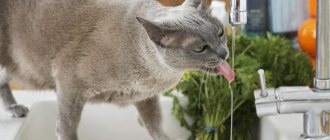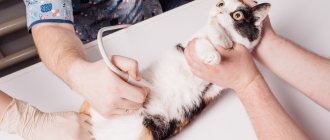Home » Home » How often can a cat give birth: how many kittens will there be for the first time
People who have purchased a cat as a pet ask many questions. Much knowledge concerns the health of your pet, as there are many nuances and problems.
Owners of purebred animals that are intended to reproduce offspring especially need to know a lot.
A cat gives birth for the first and second time: how many kittens will there be?
It is usually important for owners to know how many kittens will be in the litter. Thanks to a preliminary forecast, you can immediately solve a lot of practical problems.
The place, with what parameters to prepare for a cat with kittens, what kind of assistance should be provided to a woman in labor during the lambing process, how many kittens should be distributed.
It is almost impossible to find out exactly how many kittens a cat gives birth to the first time and the second time. There are unspoken “calculators”, but they rarely work.
On average, the first and second litter can produce from 4 to 6 kittens.
The number of kittens can be more than 10 or less than 4 - it all depends on many factors:
- Too young, old cats produce up to 4 babies in one lambing. The maximum number of offspring is between the ages of 3 and 6 years.
- Heredity and the breed of the animal significantly influence the number of kittens. The rarer the breed, the fewer kittens the female will give birth to at one time.
- The conditions in which the female is kept, nutrition and care all significantly affect pregnancy and the process of conception.
- Male genetics, sperm quantity, quality of sexual intercourse.
- Hormonal background of the female at the time of conception, previous diseases.
Several of the above conditions may simultaneously affect the quality and quantity of future offspring.
Methods for determining the number of fruits
A responsible breeder, as a rule, wants to know exactly the number of future babies a pet will have. How to determine how many kittens a cat will have? Some experts claim that the number of future babies can be determined by the number of nipples the mother has. However, this method is not accurate. Feeling the cat's abdomen to determine the number of fetuses is an unsafe technique for the pet's health and is not informative. Even a veterinary specialist needs to be very highly qualified in order to accurately determine the number of future offspring in this way and not harm the babies and mother. Palpation is most often carried out on 20 - 21 days after mating or on the 49 - 55th day. These dates are due to the fact that after the 21st day the uterus is filled with amniotic fluid, making diagnosis much more difficult.
The safest and most informative method for the expectant mother is an ultrasound examination of the uterus. An ultrasound can be performed to determine the number of kittens starting from the 21st day after mating. By this period, you can determine the number of fetuses in the womb and listen to their heartbeat.
A responsible breeder is rightly puzzled by the question of how to find out how many kittens a cat will have. This allows him to competently approach issues of assistance during childbirth and solve the problem of selling young animals in advance. Knowledge of the causes and factors influencing multiple pregnancy, knowledge in the field of genetics will help you choose the right stud cat for your pet, follow the rules of feeding and keeping the animal during pregnancy.
A cat's pregnancy raises a lot of questions for the owner: how to care for the pet, how the birth goes and, of course, how many kittens to expect in the litter. Today we will answer the last of the questions regarding the number of kittens in a cat’s litter.
How often can you give birth?
A sensitive issue that worries good owners concerns how often a cat can give birth. There are several opinions that differ significantly.
Note! When making a decision, it is worth considering the cat's health characteristics.
Veterinarians and professional breeders of certain breeds give different recommendations regarding the frequency of lambing.
Fans adhere to completely different norms, dosing cats with hormonal pills at the time of estrus to stop the process.
How often can a cat give birth:
| Who makes the recommendation regarding the issue? | Top advice regarding lambing |
| Experienced cat breeders | It is recommended to breed a female according to the plan. Typically lambing is planned once a year. It is believed that the female’s body is in harmony and the quality of the litter will be much better |
| Experienced hosts | They say that it is enough for a cat to give birth 2 times a year. This will allow you not to overstrain your body and keep it in good shape. Otherwise, the animal begins to get sick often and behave inappropriately. |
| Veterinarians | Catch a cat when it comes into heat. Therefore, births may not be limited to 3-4 in 1 year. If the animal's needs are ignored, health problems may arise, leading to infertility and even death. |
How many kittens will a cat have in a year and in her entire life?
It is almost impossible to accurately determine the number of kittens that a cat can produce in a year, much less in its entire life.
Figures may be approximate and depend on many factors and conditions.
What conditions can affect the number of offspring:
- The average cat of reproductive age can produce 5 kittens in one lambing. Depending on the number of matings, cat lovers should expect from 10 to 20 kittens per year. Over an average lifespan, the number can reach 140 individuals.
- If the female is fertile enough, approximately 25 kittens can be expected per year. Over a lifetime, the number may be 250 individuals.
- A particularly fertile female can give birth to up to 30 kittens over the course of a year. Over the entire period of existence - 300 kittens.
The figures are approximate and limited by quantity, not quality.
Some cats live long enough to produce offspring throughout their lives. Others give birth less frequently and up to a certain age.
Attention! The cat will not be in a stressful state if the number of lambings in 365 days is 3-4 times.
Owners can independently control the number of lambings of their pet, therefore they directly influence the size of the offspring.
If the animal is often sick, or the birth was complicated, then it is worth limiting the number of matings.
How long does pregnancy last in cats of different breeds?
A cat's fertility largely depends on its lifestyle. If she has free access to the street, then the frequency of sexual intercourse increases. This means that the probability of becoming pregnant will be higher than for a pet spending its life in isolation at home.
A purebred animal should not be allowed to engage in promiscuity. This will negatively affect the genetics of future offspring and can lead to pathologies in kittens.
© shutterstock
Pregnancy in domestic cats lasts an average of 9 weeks. The timing of gestation differs depending on the breed:
- for short-haired breeds (Abyssinian, Burmese, Russian Blue, Egyptian Mau, etc.) - 58–68 days;
- for long-haired breeds (Siberian, Persian, Norwegian Forest, etc.) - 63–72 days.
In addition, the duration of pregnancy is influenced by the physiological and individual characteristics of the expectant mother.
How does childbirth take place and how many hours?
In order for your cat to lamb without complications and for all the kittens to be alive and healthy, you need to help your pet.
Every pet owner should provide assistance correctly and efficiently, and know the main stages and features of childbirth.
To cope with childbirth in a cat, it is enough to familiarize yourself with the process using special literature.
If an animal develops complications before or during birth, you should definitely call a veterinarian.
How does childbirth occur in a cat?
- The first stage is determined by the beginning. Contractions can be determined in accordance with the behavior of the animal. The female begins to look for a suitable place, constantly hangs around the owners and becomes noticeably nervous, experiencing painful sensations.
- After the end of the first stage, which lasts from 12 to 24 hours, the time comes for the second. At this moment the attempts begin. The cat no longer moves, the amniotic fluid is leaking. At this moment, it is advisable to stay near the pet for as long as possible.
- The cat does not need help during the birth process. It is enough to accept the kittens and lay them down so that the new mother cannot crush or injure the babies. If the kitten walks not with its head, but with its legs forward, then the animal needs help: slightly pull the kitten by the paw forward, and then down.
Lambing will end in about 1-3 hours. The young mother will begin to lick and feed her offspring. To prevent the animal from getting up again, you need to place food and drink nearby.
For the first 3 days, it is worth closely monitoring the health of the female and the offspring. During this time, problems or pathologies will appear that may affect the further quality of life.
Useful video
Share this post
- Related Posts
- Beautiful handwriting: in block and capital letters for adults and children
- How to use the beneficial properties of peach oil for diseases of the throat, nose and cosmetology
- Cocoa butter: characteristics, properties and applications in cosmetology, cooking and medicine
- How to properly prepare for confession, as well as a list of sins for women and men
- List of beautiful American female surnames and what they mean
- Beautiful and touching declarations of love to a girl that brings her to tears
Discussion: there is 1 comment
- Motherinstvo.Info:
09/15/2018 at 02:11The article contains all the necessary information for the owner of the animal, supported by a photo in order to learn how to distinguish a cat from a cat. It will also be useful to learn how to properly feed a kitten at 10-12 weeks.
Answer
How to understand that a cat is about to give birth
During the entire pregnancy, certain hormones are released in the cat’s body, which are responsible for restraining the birth process and its initiation.
Two hormones play a major role: oxytocin and progesterone.
- Progesterone delays the onset of contractions, gives muscles and ligaments elasticity, allows the abdomen to lower and the birth canal to expand.
- Oxytocin is a hormone that initiates labor and lactation. A critical concentration of oxytocin in the blood provokes the production of a number of other hormones, including adrenaline, which prevents the cat from falling asleep.
If you notice that your pet is awake for a long time and “fussing around,” you need to establish sensitive control over its behavior. You can be sure that your cat is about to give birth if the signs described below are observed.
Signs that your cat will give birth in a few days
A sure sign that a cat will give birth in the next few days is changes in behavior and anxiety. About two weeks before giving birth, the pet periodically experiences so-called false contractions. Moderate contractions help push the kittens toward the birth canal and gradually prepare the cervix for dilation.
You can be sure that a cat is about to give birth if she spends most of the day in the nest and grooming herself. Examine the pet's abdominal cavity; before giving birth, there is a noticeable increase in the size of the mammary glands.
By feeling the peritoneum, you will feel that the local temperature is slightly increased. The breasts will appear pink, wide, and noticeably prominent.
The cat will give birth today: signs
During the last weeks of pregnancy, your cat's appetite increases greatly. She will eat often, but little by little, since her stomach is strangled by the constantly moving kittens.
About a day before giving birth, the cat will refuse to eat or will eat food very reluctantly. At the same time, water consumption does not decrease, but most often increases.
Your cat will begin to give birth after she has gone into labor. During the first stage of labor, the interval between contractions can reach 30–40 minutes. During this period, the cat cannot sleep, but will most likely nap to gain strength. The active phase of labor occurs when the interval between contractions is 30–40 seconds.
If your cat is giving birth for the first time, be sure to time the time between contractions. The problem is that training contractions are quite intense in the last week of gestation. The cat may show genuine excitement, prepare for childbirth, call the owner, and then calm down and go to bed.











